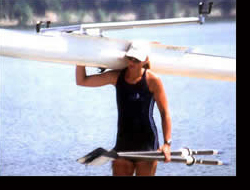 Why Row
Why Row
See our FAQ page for more info
Rowing is a non-impact aerobic resistance exercise that, if not rowing alone in a single scull, emphasizes teamwork. No other human endeavor requires working together with others to a greater degree than crew rowing. As adults we tend to choose sports like tennis, golf, or skiing: sports where teamwork is emphasized much less. Working together with two, four, or eight others towards a common goal is something that we do not usually get to experience. Within rowing that camaraderie can be found.
For those who want to be alone, the single scull is available. A single scull requires a solitary attempt at perfection. Like any technique sport, rowing requires an apparent paradox: working hard while remaining relaxed. Rowing with efficient technique, a competitive crew looks as though everything is calm and effortless hiding the intense physical effort involved.
The rowing stroke is a horizontal weightlifting exercise. If you were to turn the boat so that the bow was pointing skyward, the stroke motion would look similar to lifting a barbell. Just as in weightlifting, proper technique emphasizes using the legs for most of the power to lift. Proper body posture protects the back from injury. An Olympic oarsman pulls his oar with an approximate force of 70 pounds from beneath his feet to just below his ribcage, at about 40 times a minute for 6 minutes. Each man produces better than one half horsepower for the duration of the race, achieving a four minute mile and sprinting to speeds of better than 20 mph.
As seen on the TV show Mythbusters, an eight-man shell can pull a water skier. While most of us do not intend to achieve such a level, rowing is an extremely good aerobic workout and uses every major muscle group. Whether you intend to row recreationally or choose to compete, you need only work to your personal level so rowing can be an excellent rehabilitation activity.

